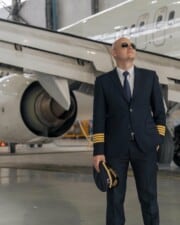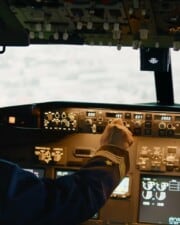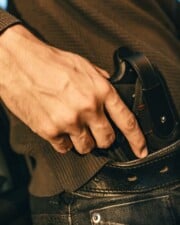Everyone knows that it’s really important for pilots to have good vision along with a host of other qualities. They need to be alert and ready to deal with a whole host of air tasks that require good eyesight from takeoff until landing. However, do they need to have naturally good vision, or can they use visual aids, such as glasses?
The good news is that you don’t need to have perfect vision for flying, and pilots can wear glasses. The answer to “Can pilots get Lasik?” “Can pilots be color-blind?” or “Can pilots wear contacts?” is also a resounding yes. However, there are certain medical requirements for civilian flying and for flying in the military, and if a person’s uncorrected vision is too bad, they can’t become a pilot.
For everything you need to know about flying with corrected vision, keep reading!
Can Pilots Wear Glasses?
Yes, pilots can wear glasses. According to the FAA, to pass a medical exam, a pilot’s vision has to be 20/20 or better in each eye—with or without correction. That means that as long as someone applying for a pilot’s license can see 20/20 or better with the help of glasses, that person will be able to get their license.
It’s a common misconception that pilots have to have 20/20 vision without correction to get a license. However, the goal of the FAA is to ensure that pilots can actually see where they’re going. It doesn’t matter if they need the help of glasses or other corrective aids to achieve that vision. The only difference is that the pilot’s license or certificate will specify any visual limitations or if corrective lenses are required.
The only requirement is that if a pilot needs glasses to pass the vision test, that person must wear glasses while flying. Nearsighted pilots are required to wear glasses whenever flying, while farsighted pilots only need to wear them as needed but must have the glasses available at all times.
The FAA and other agencies do have minimum requirements for uncorrected vision, even if you know that you need glasses. People who have very bad eyesight are sometimes banned from working as pilots. Additionally, pilots, as they age, need to retake vision tests, and the requirement gets stricter to compensate for potential loss in reflex times.
Can Pilots Wear Contacts?
If pilots can wear glasses, then what about other types of corrective vision aids, such as contact lenses? The short answer is that yes, pilots can absolutely wear contacts. Anything that a pilot needs to see well enough to pass the official vision test is permitted (except for outright cheating, of course). Just as with glasses, if a pilot needs to wear contact lenses, the license or certificate will specify that corrective lenses are required.
However, there are limitations on the type of contact lenses that pilots can wear while flying. Monovision or bifocal contact lenses, which correct for near and far vision at the same time, are forbidden for pilots. That’s because having lenses for both distances in your eyes at the same time affects your depth perception, and depth perception is the most important aspect of vision for pilots.
Pilots who pass their vision test using contact lenses are usually required to wear their contact lenses while flying and to have a backup pair of glasses in their bag. Anyone who wears contacts knows that sometimes flecks of dirt get caught in your eye or the lens moves, impeding your vision, so it’s crucial for someone with as important a job as a pilot to have a backup way of seeing just in case.
Can Pilots Get Lasik?
When the FAA talks about pilots requiring corrective lenses, corrective eye surgery actually falls under that umbrella. According to the FAA’s own requirements, pilots with Lasik can fly without any limitations as long as the surgery was successful. After the surgery, pilots may need to retake the vision test to prove that their vision is now 20/20.
However, Lasik is not always successful in removing all of a patient’s vision impairments. If a pilot still has some visual impairment after surgery, that person will still have to wear contact lenses or glasses, and the certificate will note that corrective lenses are required. Since Lasik isn’t always successful and some patients experience a period of poorer vision immediately after surgery, currently-active pilots should talk carefully with their doctors about the risk of surgery before getting it.
However, just the act of having Lasik surgery doesn’t disqualify anyone from getting a pilot’s license. The important factor is the state of the potential pilot’s vision after the surgery, which the relevant governing body will check using a vision exam.
Can Pilots Be Color-Blind?
One of the most common pilot-related misconceptions is that pilots can’t be color-blind—even people who know pilots can wear glasses often assume that they need perfect color vision. However, pilots can be color-blind as long as they meet the minimum threshold for color vision.
The standards for color vision are a bit stricter than for regular vision, so if you are only slightly color-blind, you are likely in the clear, but people with severe color blindness cannot get a full pilot’s license. Unlike glasses for regular vision, there are no corrective lenses available to help with color blindness. Although there are some contact lenses that claim to help with color vision, those are still banned by the FAA, so if you fail your color vision test, you are in trouble.
However, you can still get some form of a pilot’s license even if you’re color-blind. For example, if you can prove that your color blindness doesn’t affect your ability to see colors relevant to a pilot’s job, just colors that are not as commonly found in aviation, you can get a full pilot’s license. Another option for pilots with some form of color blindness is to get a license that allows them to fly during the day but not at night. A commercial pilot’s license is usually out of reach for people with color blindness, but a private pilot’s license isn’t.
What Are Vision Requirements for Pilots in the Military?
As you can probably guess, the vision requirements for being a pilot in the military are somewhat stricter than they are for civilian pilots. Pilots in the Navy need at least 20/40 vision uncorrected, and in the Army, the requirements are more generous with 20/50 vision. As expected, requirements in the Air Force are the strictest, with pilots needing 20/30 nearsighted vision or 20/70 farsighted vision without correction.
However, even pilots in the military are allowed to wear corrective lenses to get their vision to that ideal measurement of 20/20. Even pilots in the Air Force are allowed to wear glasses, rely on contact lenses, or undergo Lasik surgery to get their vision to perfection. Although the baseline requirements are slightly stricter for military pilots than they are for civilian and commercial pilots, they are not so strict that corrective lenses are excluded.
There are many misconceptions about physical requirements for pilots, including minimum and maximum heights and uncorrected perfect vision. The truth is that even military pilots can wear glasses!
References ▾
Related Posts













